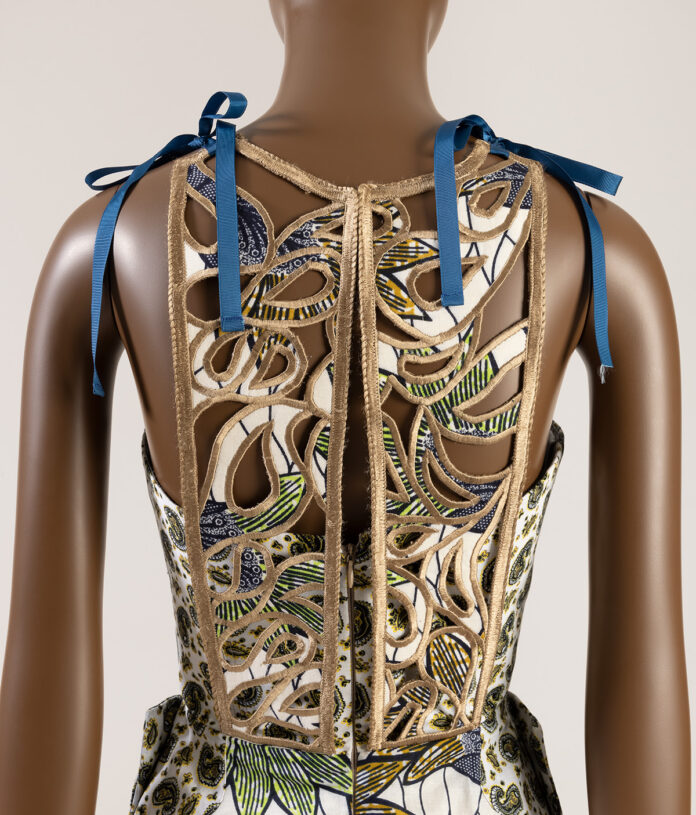![]()
![]()
![]()
![]()
![]()
![]() The Museum at FIT (MFIT) presents Africa’s Fashion Diaspora, an innovative exhibition that explores fashion’s role in shaping international Black diasporic cultures. This exhibition is the first to examine fashion as a mode of cross-diasporic cultural production. Sixty ensembles and accessories by Black designers from Africa, Europe, North and South America, and the Caribbean are placed in dialogue with each other, showing how these designers take complex inspirations from their own Black cultures and others across the diaspora.
The Museum at FIT (MFIT) presents Africa’s Fashion Diaspora, an innovative exhibition that explores fashion’s role in shaping international Black diasporic cultures. This exhibition is the first to examine fashion as a mode of cross-diasporic cultural production. Sixty ensembles and accessories by Black designers from Africa, Europe, North and South America, and the Caribbean are placed in dialogue with each other, showing how these designers take complex inspirations from their own Black cultures and others across the diaspora.
The concept that Black peoples build and share common cultural networks—despite differences in geography, ethnicity, gender, sexual orientation, language, and religion—is an enduring idea that scholars and leaders such as W.E.B. DuBois, Frantz Fanon, Kwame Nkrumah, and Paul Gilroy have hypothesized over the 19th and 20th centuries. Self-identified Black peoples within the diverse nations of Africa and throughout the Black Diaspora have expressed this connectivity as Pan-Africanism, Black Consciousness, and Afrocentricity, among many other movements.
While Black Diasporic connections have been explored in music, literature, art, and philosophy, this exhibition is the first to investigate how 20th- and 21st-century fashion designers contribute to these conversations with creative practices that focus on visual storytelling to explore how Black identity operates in the contemporary world.
The exhibition includes nine themes. “Reaching for Africa“ opens the exhibition by considering the multi-layered reasons that Black American designers such as Patrick Kelly and Arthur McGee create connections to Africa in their work. These designs, from the 1960s to today, sometimes lean on idealized conceptions of Africa, but they also work to repair severed cultural heritages, express Black solidarity, and celebrate Black cultures.
“Mothers and Motherlands” explores the influence of family, lineage, and cultural tradition on fashion design from a specifically Black perspective. South African designer Thebe Magugu, for example, venerates Tswana motherhood practices through his 2023 Mother and Child dress. Fabrice Simon, who ran a family fashion business during the 1980s, spanning New York City and his birth city of Port-au-Prince, Haiti, worked with expert Haitian beaders to modernize their historic motifs.
In “A Black Atlantic” designers draw inspiration from Black cultures across multiple locations, finding similarities or personal points of interest. French designer Olivier Rousteing takes inspiration from Black American cowboys for his 2021 Balmain capsule collection, while the Ivorian brand Kente Gentlemen’s The Birth of Cool collection looks at international musicians from Fela Kuti to Miles Davis.
The designers in “Homegoing” investigate the roots of their own family histories, reflecting wider social trends for identifying cultural origins. Dutch designers Giorgio Toppin and Onitcha Toppin of Xhosa created their KABRA collection in Suriname, connecting with the skilled textile artisans there, as well as with their own heritages. Telfar Clemens designed the Olympic uniforms for the Liberian national team in 2021 after they reached out to him during a trip to his country of birth.
“History Is Political” demonstrates fashion as a key vehicle for communicating buried histories. Tremaine Emory’s Denim Tears Cotton Wreath capsule collections with Levi’s link the labor of 19th-century enslaved Americans to international capitalist systems. Colombian designer Esteban Sinisterra Paz shapes history as it is made, designing the 2022 inaugural gown for Colombia’s first Black vice president, Francia Márquez, in his signature wax print textiles.
Black designers explore the cultural impact of religion and mythology in “Transcendent and Supernatural.” American Grenadian designer Fe Noel partnered with Harmonia Rosales to feature the artist’s depiction of Oshun, the Yoruba goddess of rivers, love, and fertility. Papa Oppong’s (Fashion Design MFA ’23) “Witchcraft” ensemble sheds light on the harmful practice of accusing Ghanaian women of channeling dark magic and recasts the witch as an empowered modern woman.
Textiles from Africa and the diaspora are emblematic of the artisanship and creative practices found in Black communities around the world. “Monumental Cloth” features designers who work with communities of weavers and dyers to produce contemporary fabrics rooted in historical practices: from Pathé’O in Côte d’Ivoire to Emmanuel Okoro of Emmy Kasbit in Nigeria to Aurora James of Brother Vellies in the United States.
“Tun Yuh Han Mek Fashan” is a Jamaican patois phrase that describes Caribbean ingenuity, the ability to create beauty and utility from meager or unexpected resources. This section features designers from across the African Diaspora who engage innovative materials to promote sustainability in fashion. Nairobi Apparel District upcycles secondhand garments with graphic motifs to create modern Kenyan streetwear, and Dyandra Raye designs vegan shoes from Piñatex for her brand Jo-Anne Vernay.
“Ubuntu” is a Bantu word that has come to encompass African humanist philosophies of community support, compassion, and generosity. Designers—from Tracy Reese, whose Hope for Flowers brand is helping to revitalize urban Detroit, to Akosua Afriyie-Kumi, whose AAKS accessories brand consciously pays fair wages to raffia weavers in northern Ghana—show how fashion companies can be a force to build communities with job security and respect for labor.
Africa’s Fashion Diaspora ultimately reveals fashion as a significant contributor to international dialogues on Black cultural production. Some of the designers featured use fashion to document, explore, and interrogate their own localities and histories, while others take inspiration from across the diaspora—and because fashion circulates internationally, all build networks across a specifically (but not exclusively) Black cultural space. Black communities across the globe are uniquely situated in their own societies, yet movements for solidarity and connection are beautifully expressed by designers who use fashion to tell stories of parallel, interconnected, and evolving Black cultures.
Africa’s Fashion Diaspora is curated by Elizabeth Way, associate curator of costume at The Museum at FIT.
Africa’s Fashion Diaspora is accompanied by a multi-author volume edited by Way and published by Yale University Press which will be released in September 2024.
The Museum at FIT is a proud partner of Bloomberg Connects, a free digital guide to cultural organizations around the world that makes it easy to access and engage with arts and culture from mobile devices, anytime, anywhere. The Bloomberg Connects app, available for download from Google Play or the App Store, makes the museum accessible for onsite or offsite visits through photographs, audio, and video features that offer insights into the world of fashion and design. For Africa’s Fashion Diaspora, the app will feature an audio tour led by the exhibition curator.
Africa’s Fashion Diaspora has been made possible thanks to the generosity of the Couture Council of The Museum at FIT. This project is supported in part by the National Endowment for the Arts. To find out more about how National Endowment for the Arts grants impact individuals and communities, visit www.arts.gov.







